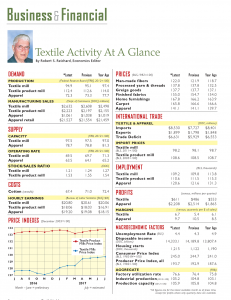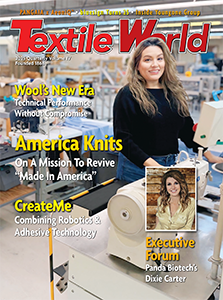BOXMEER, the Netherlands — August 31, 2017 — SPGPrints will present its comprehensive machine and ink solutions to drive the uptake of digital textile printing in Central America at Fespa Mexico 2017, Centro Citibanamex, Mexico City, 21-23 September.
Featured on the SPGPrints stand (A28) will be video presentations and information about the award-winning PIKE® and JAVELIN® digital textile printers. Both printers use SPGPrints’ unique Archer® technology and Fujifilm Dimatix Samba print heads to fire variable drops of ink (2-10 picoliters) from a distance of up to 4 millimeters onto the substrate, to deliver optimum saturation, precision and speed, on a wide variety of natural and synthetic textiles.
The Javelin is a digital production scanning printer aimed at companies taking the first step into digital printing, or supplementing an existing digital capability. It is designed for textile printers requiring up to 2 million linear metres per year. For larger volumes, SPGPrints also offers the Pike, a single-pass, high-speed production printer.
Also highlighted on the stand are SPGPrints’ inks for digital printers using Kyocera print heads. Acid, reactive, disperse and sublimation inks are all manufactured by SPGPrints at its newly expanded 1000m2 ink production facility, located at the company’s Boxmeer (Netherlands) global headquarters. Working in close conjunction with leading print head manufacturers, SPGPrints’ inks ensure smooth running, wide colour gamuts, outstanding quality and low maintenance.
Information and samples from solutions and innovations demonstrating SPGPrints’ continued commitment to the conventional rotary screen sector will also be on display and available for inspection. SPGPrints offers high-accuracy and high-productivity screen-imaging solutions to meet the requirements of all textile printers. The SPGPrints bestLEN direct laser engraver can image screens in as little as half an hour without films, chemicals or exposing and washing processes. The smartLEX laser imaging system uses multi-beam diode technology for fast, precise screen imaging.
Part of SPGPrints’ rotary screen offering are its latest screens with fine meshes to meet exacting standards. The NovaScreen® range offers high quality, durable, reuseable, nickel screens in mesh sizes from 135 to 245. The NovaScreen 245 mesh offers the highest possible resolution in printing with sharp lines and geometrical designs. The RandomScreen® is a 125 mesh screen with the position of each hole slightly out of line. This eliminates moiré when printing problematic textiles or designs.
Supporting these innovative technologies is SPGPrints Mexico, SA de CV. Based in San Antonio, Mexico City, and providing local expertise, service and support, the company has a deep understanding of the Mexican market, and can react quickly to ensure that its customers enjoy maximum uptime, print quality and productivity.
“We are very excited about Fespa Mexico,” said Fernando Montes, managing director, SPGPrints Mexico. “The Mexican market is on the cusp of taking its first serious steps into high-volume digital textile production, and the PIKE and JAVELIN printers offer the combination of speed, print quality, flexibility and cost-effectiveness that our customers, and others, have been waiting for.”
The launch of the single-pass Pike printer at ITMA Milan, in 2015, was a milestone in textile printing, ushering in the age of high-volume digital textile production. It won the European Digital Press (EDP) Award for the Best Industrial Textile Solution in 2016.
The Javelin printer, launched a year later, uses the same print heads, ink, and Archer technology. It uses multi-pass scanning technology to print up to 367 linear metres per hour, which equates to 2 million linear metres per year, in web widths of 1850mm or 3200mm. The Javelin won the EDP Award for Best Textile Solution, in 2017.
“Both Pike and Javelin are well-suited to the Mexican market,” Montes continued. “They offer production flexibility, cost-effective short runs, fast turnarounds, and high print quality.”
Archer technology and Pike and Javelin inks, through the use of variable drops, extends the colour gamut so that it is wider than the high-definition (HD) gamut of other digital textile printing solutions. Adding to SPGPrints’ value proposition, the Archer Print Head Program offers a 2.5 year warranty on print heads, in combination with use of accredited inks, significantly reducing running costs.
Mexico: growing interest in digital textile printing technology
“We’re finding the interest in digital printing to be very high,” Montes said. “I would say that about three-quarters of our conventional rotary screen customers have expressed a strong interest in investing in this technology within the next few years.”
The Mexican market, like those around the world, is increasingly driven by the internet and cost-pressure. Online shopping and fast-fashion retail outlets mean that garments are more time-sensitive than ever. Time-to-market is a vital factor for fashion suppliers and retailers, and shorter, cheaper and more efficient supply chains are needed. There is a great need to reduce stock levels and seek leaner textile production workflows.
“Digital printing answers all these requirements,” Montes said. “With only the quantities required being printed, and no prepress processes, waste is slashed; chemical purchase, storage and disposal are eliminated, making the end-to-end production process sustainable.
“The ability of printers with a digital capability to change designs on-the-fly means that different patterns and sizes can be printed in quantities as low as one. Print placement is also possible, to ensure that design elements are placed in the same relative position on every garment regardless of the size.”
Digital textile printing is also able to respond to other characteristics of the Mexican market.
“At present, there is about a 60-40 split between polyester and cotton garments,” said Montes. “Digital printing is able to create a more attractive look and feel without impacting price – which is also a major force in the market.
“Digital also produces solid blotches, fine lines and detail, including micro floral patterns, as well as sharp, even geometric patterns,” he explained. “Apart from the look and feel, consumers are now much more exacting about quality. They want their fashion to be inexpensive, but they don’t want to look, or feel, cheap.
“The digital proposition fulfils all those criteria, and textile printers who wish to remain on the leading edge will find much to interest them on the SPGPrints stand at Fespa Mexico,” Montes concluded.
Posted August 31, 2017
Source: SPGprints





